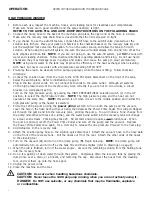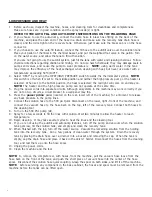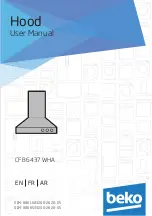
OPERATION
REFER TO THE DIAGRAMS ON THE PREVIOUS PAGE
HIGH PRESSURE WASHER
1
Before each use, inspect the machine, hoses, and cleaning tools for cleanliness and completeness.
Make sure hoses are in good condition and the spray nozzle(s) is tight.
REFER TO THE AUTO-FILL AND AUTO-DUMP INSTRUCTIONS ON THE FOLLOWING PAGES
2. Connect the dump hose to the back of the machine, and place the open end of the hose in a drain.
Make sure the recovery tank drain hose is closed and that the lid is screwed on tight.
3. If you choose to use the auto-fill feature, connect the fill hose to the autofill valve (located over the
solution tank fill hole. Place your gallon of chemical in the chemical basket on the recovery tank lid, and
put the weighted foot valve into the gallon. Turn on the water source, and allow the tank to fill with
solution. When using the auto-fill system, the auto fill valve will automatically turn on and turn off as the
tank empties and then fills. NOTE: If you are not going to use the auto-fill system, just fill the tank with
water and cleaning chemical. Follow chemical directions regarding dilution and mixing. Do not use harsh
chemicals; they may damage seals in pumps and valves, and cause the pump to wear prematurely.
NOTE: using warm water in the tank may improve the efficiency of the heat exchanger when cleaning
with heat, but never use water with a temerature exceeding 54ºC/130ºF.
4. Pre-spray the area to be cleaned, with a pump-up sprayer, while the tank is filling. Follow chemical
directions.
5. Connect the solution hose (from the reel) to the 1200 PSI Quick Disconnect on the front of the tank,
below the switch plate. Refer to illustration on page 3.
6. Plug in the two power cords. Do not connect both cords to the same outlet. Although all systems
on the high pressure side of the machine may work correctly if you are not on two circuits, a circuit
breaker in a wall panel may trip.
Turn on the high pressure pump by placing the HIGH PRESSURE/HEAT selection switch (2) in the UP
position, to select the High Pressure Pump. NOTE: The high pressure pump and the heat can not
operate at the same time. NOTE: this switch is off when it is set to the middle position and neither the
high pressure pump or the heater is selected.
7. Prime the 1200 psi pump using the ‘power prime’ system: turn on both the pump and the vacuum,
cover the hole in the hose barb with your hand, then depress the Power Prime Pedal. This will pull trapped
air through the pump and into the recovery tank
, priming the pump. You will notice a ‘tone’ change from
the pump (smoother, with less of a rattle), and the water being pulled into the recovery tank will change
to a clear, solid stream. Priming may take 20 - 60 seconds and will require a full solution tank. When
the pump is primed, let off the Power Prime Pedal, and turn off the pump and the vacuum. Depress
the Power Prime Pedal once again, for a moment, to release the line pressure. Proceed to the next step.
8. Add defoamer to the recovery tank.
9. Attach the solution spray hose to the solution quick disconnect. Attach the vacuum hose to the hose barb
on the front of the recovery tank. Pull the hoses out from the reel. Attach the other ends of the hoses
to the cleaning tool.
10. Turn on the vacuum (3) and turn on the dump pump (5). Begin spraying. NOTE: the dump pump will
automatically turn on and turn off as the tank fills and then empties (refer to drawings on page 8).
11. When the job is finished, turn off the water source. Vacuum the remaining solution from the holding tank
into the recovery tank.
12. Run a few gallons of clean water through the system. Completely drain the recovery tank by placing the
dump hose over a drain, or a bucket, and removing the cap. Disconnect the hoses from the cleaning
tool, and reel them up onto the hose spool.
13. Unplug the power cords.
14. Clean the machine and the tool.
CAUTION
: Use care when handling hazardous chemicals.
CAUTION
: Never leave the 1200 psi pump running when you are not actively using it.
DANGER:
Do NOT use solvents, or any chemicals that may be flammable, explosive
or combustible.
5
Summary of Contents for KING COBRA-1200 PRO 240V
Page 9: ...9 240V...






























